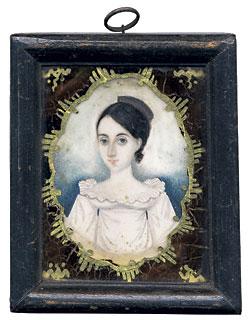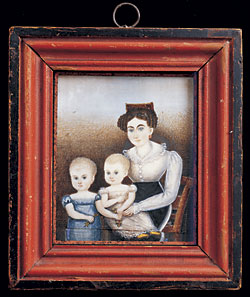Abraham Parsell Miniature Painter
This archive article was originally published in the 8th Anniversary issue of Antiques & Fine Art magazine.
Little is known about the painter Abraham Parsell (1791-1856), whose miniature portraits on ivory continue to charm us today. He produced small, mostly oval portraits housed within a chased metal pendant style frame, often with a small oval aperture on the back to house a lock or woven specimen of the sitter's hair.1 Signed examples of his work have been recorded but are extremely scarce2 and, although he describes himself as a "miniature painter" in his last will and testament,3he left no indication as to how he became an artist, why he chose this profession, or under whom he may have apprenticed. Our research answers many previously unanswered questions about Parsell, but as gratifying as it is to have uncovered so much information there is much to be learned.
Abraham Parsell was born in Neshanic, New Jersey, on June 17, 1791, the second of six children in the family of Oliver Parsell and Lucretia Williamson Parsell, who married on July 21, 1788. Abraham himself married Mary Richards in Essex County, New Jersey, on March 23 1819.4 Their first and only surviving child, John H. Parsell, was probably born on the same year. Though John H.'s exact birth date is unknown, he is recorded in the 1880 census as sixty-one years old. Two more children born to Abraham and his wife died in infancy.
Parsell moved to New York City to ply his trade; the far more common path would have been an itinerant practice. The year he arrived has not yet been discovered but he is listed as a miniature painter in the city's directories as early as 1820.5 In New York, Abraham competed with academically trained artists, yet maintained his career for some thirty-six years -- proof that the images he created pleased his clientele.
Abraham changed addresses several times but appears to have preferred Lower Manhattan. In the Longworth's directory6 of 1822-23, Abraham is listed as a miniature painter at 28 Bayard. The same directory for the years 1825-26 list his profession as the same, but his address is now 25 Oak. In the 1830-31 directory he is at 46 McDougal Street where he stayed for the remainder of his career. The only known example of a trade card showing the 46 McDougal Street address was found inserted behind a portrait miniature and secured within its frame (Fig. 1). The Dogget directory7 for 1843-44 is the first to include Abraham's son, John H., also listed as an artist and at the same 46 McDougal Street address. Subsequent directory listings indicate that John H. remained with his father at that address until 1848. The 1848-49 directory lists John H. still as an artist, but now on his own at 34 Commerce. In the 1851-52 directory he is back at 46 McDougal.
Several characteristics distinguish Abraham Parsell's work. His earlier portraits are noticeable for their absence of hands and props, and they have more subtly colored, less complex backgrounds than his later works (Fig. 2). Another recorded portrait, of an unknown gentleman, (the present whereabouts of which are unknown), is amongst the earliest known work by Abraham Parsell and dates to around 1820. A paper insert behind the portrait bares the inscription "A. Parsell 22 Bayard."8
In later portraits (Figs. 3-4) the sitter is often shown with long, elegant fingers, pronounced eyelids, and penetrating eyes, set against a stippled background. Often the sitter is holding a book, a rolled newspaper or document, eyeglasses, and in some instances, the family pet. The sitters, many of whom were identified as residents of either New York City or New Jersey, are well dressed in stylish clothing and adorned with jewelry and elaborate coiffures. The backgrounds of many later portraits have a dramatic sunset appearance, with clouds of blues, oranges, and pinks. Shades of brown stippled pigment are often included in the background either alone or in conjunction with the atmospheric clouds.
For his later portraits, Parsell utilized the ivory's translucence to the maximum effect, painting areas of the back of the ivory in shades of blue, reddish brown, and orange to produce muted tonalities on the front of the image (Figs. 5a-b). This technique illustrates a clear understanding of the medium in which Parsell chose to work. Preparation involved scoring the ivory surface with a succession of lines barely visible to the naked eye. This was extremely effective in securing the paint to the ivory support and accounts for the many surviving examples of Parsell's work in remarkably good condition. Another technique was his use of gum arabic, a varnish-like substance used to highlight certain areas on the front of the miniature.
Parsell's portraits are generally about 2-1/2 x 2-1/4 inches. Mostly oval, some square and rectangular images have also been recorded. The most significant of these is a 3I x 2I inch triple portrait of Mrs. W. D. Bell, Samuel P. Bell, and his sister Harriet Bell of Brooklyn, New York (Fig. 6). An interesting group of portraits of five members of the Jones/Bruen family of Newark, now in the collection of the New Jersey Historical Society -- although unsigned -- stylistically fulfills all of the criteria necessary to attribute them to Parsell (Figs. 7-11).
Parsell died on February 10, 1856,9 aged sixty-five. References in his will make it clear that he was a deeply spiritual and God-fearing man. It is interesting to note the several codicils that show Abraham clearly conflicted about whether or not to leave his beloved wife all his money and real estate should she marry again after his death. He finally settled on the provision that if she remained his widow she could keep it all, but if she remarried there were strings attached.
Parsell's widow, Mary, did not remarry. When she died in 1873 at the age of eighty-two, she left, "one hundred and fifty dollars ($150.00) to pay my funeral expenses and to erect a Tombstone on my grave similar to the one on the grave of my said deceased husband I also give to my Executors Five hundred dollars ($500.00) to erect a suitable Iron Fence around the family "Burying Ground" on the property now in the possession of my brother John Richards in Springfield township East New Jersey."10Abraham and Mary, as well as their two children who predeceased them, William G., and Mary Elizabeth, are all interred in the "French-Richards Burying Ground," in Springfield, Union County, New Jersey.11 Located in an industrial area and now very overgrown, it was quite a thrill to finally place a hand on Abraham's tombstone.
Mary's will also records the following bequest; "To my beloved grandson Theodore P. Parsell I give my gold watch." Theodore P. was the son of John H. and his wife, Mary, the daughter of Thomas and Mary Starr, residents of New York.12 It is unclear just what role John H. Parsell played in the artistic pursuits at 46 McDougal Street. If, during the years at his father's studio, he merely acted as an apprentice, then surely, once he completed his apprenticeship, he produced his own work. To date, nothing can be positively attributed to him. The 1853-54 directory listing for John H. Parsell shows his profession as a letter carrier at 14 Morton. The United States census for 1880 lists him as a postal clerk. The date of his death is uncertain but he was still alive in 1900, when at the age of eighty-one, he was involved in a real estate transaction, which was recorded on May 8, in the New York Times. An encounter with John H. Parsell was recorded in Colonel L. A. Norton Life and Adventures (1887).13 After a chance meeting on a boat to Staten Island, the two returned to the city, where John H. "pointed out many relics of Revolutionary days, instructed me in my future researches, and gracefully extended me all those delicate attentions that can only be found in a heart of refinement and a mind of enlarged views."
This article was originally published in the 8th Anniversary issue of Antiques & Fine Art magazine. AFA is affiliated with Incollect.
Vincent DiCicco and Howard P. Fertig are independent researchers. Mr. DiCicco's published articles include Silhouette Portraiture in America: A Fully Developed Form of Folk Expression (Fall 2001), and Nathaniel Seymour Pottery: West Hartford Connecticut (Winter 2003-2004), both in Folk Art Magazine. Mr. Fertig's projects include being the research curator for the Museum of American Folk Art's 1994 exhibition Revisiting Ammi Phillips: Fifty Years of American Portraiture.
1. In one incident a complete ring of braided hair secured at the ends with thread, surrounds the entire portrait on the front side. This example is included in the collection of Historic Hudson Valley and is illustrated in the exhibition catalogue Beloved Keepsakes: Miniatures in the Collection of Historic Hudson Valley, Kathleen Eagen Johnson, p. 13. Mounted at Phillipsburg Manor Gallery, Sleepy Hallow, NY, May 6- September 7, 1998.
2. Beatrix T. Rumford, American Folk Portraits and Drawings from the Abby Aldrich Rockfeller Folk Art Center (Boston: New York Graphic Society, in Association with the Colonial Williamsburg Foundation, 1981), 146-147 cites signed examples.
3. New York Index of Wills 1851-1875 N-Z, Sawyer, Volume, 3. Listing: Abraham Parsell-February 20, 1856, Book 116, p. 66. Microfilm: New York County Surrogate's Court Record of Wills, Abraham Parsell, Liber 115-116, 1855-1856.
4. www.familysearch.com
5. George C. Groce and David H. Wallace, The New-York Historical Society's Dictionary of Artists in America 1564-1860 (New Haven and London: Yale University Press, 1957/1979), 489.
6. Longworth's American Almanac, New-York Register, and City Directory (New York, N.Y.: Thomas Longworth).
7. Doggett's New York City Directory (New York, N.Y.: John Doggett, Jr, & Co.).
8. Email with downloadable attachment of image dated April 3, 2006 to Howard P. Fertig, from Leslie Antiques, New York City.
9. www.findagrave.com
10. New York Index of Wills 1851-1875 N-Z, Sawyer, Volume, 3. Listing: Mary Parsell-July 23, 1873-Book 215, p. 332. Microfilm: New York County Surrogate's Court Record of Wills, Mary Parsell, Liber 214-215, 1873-1875.
11. www.findagrave.com
12. www.proquest.com Pro Quest Historical Newspapers: The New York Times (1857-Current file) (New York, N.Y.: August 11, 1865): 5, Died. The death announcement reads as follows: Starr-On (sic) Wednesday morning Aug. 9, Mary Starr, reliet (widow) of Thos. Starr, in the 84th year of her age. Her relatives and friends, also the friends of her sons Thomas, George and James Starr, are respectfully invited to attend her funeral, from the residence of her son-in-law, John H. Parsell, No. 46 Macdougal-st. (sic), on Friday afternoon, at 2 o'clock.
13. http://lcweb2.loc.gov/gc/calbk/189/189sgm_old Library of Congress -- Historical Collections (American Memory) Life and Adventures of Col. L. A. Norton: a machine-readable transcription, written by himself. (Oakland, Cal.: Pacific Press Publishing House, 1887), 398-400.




































